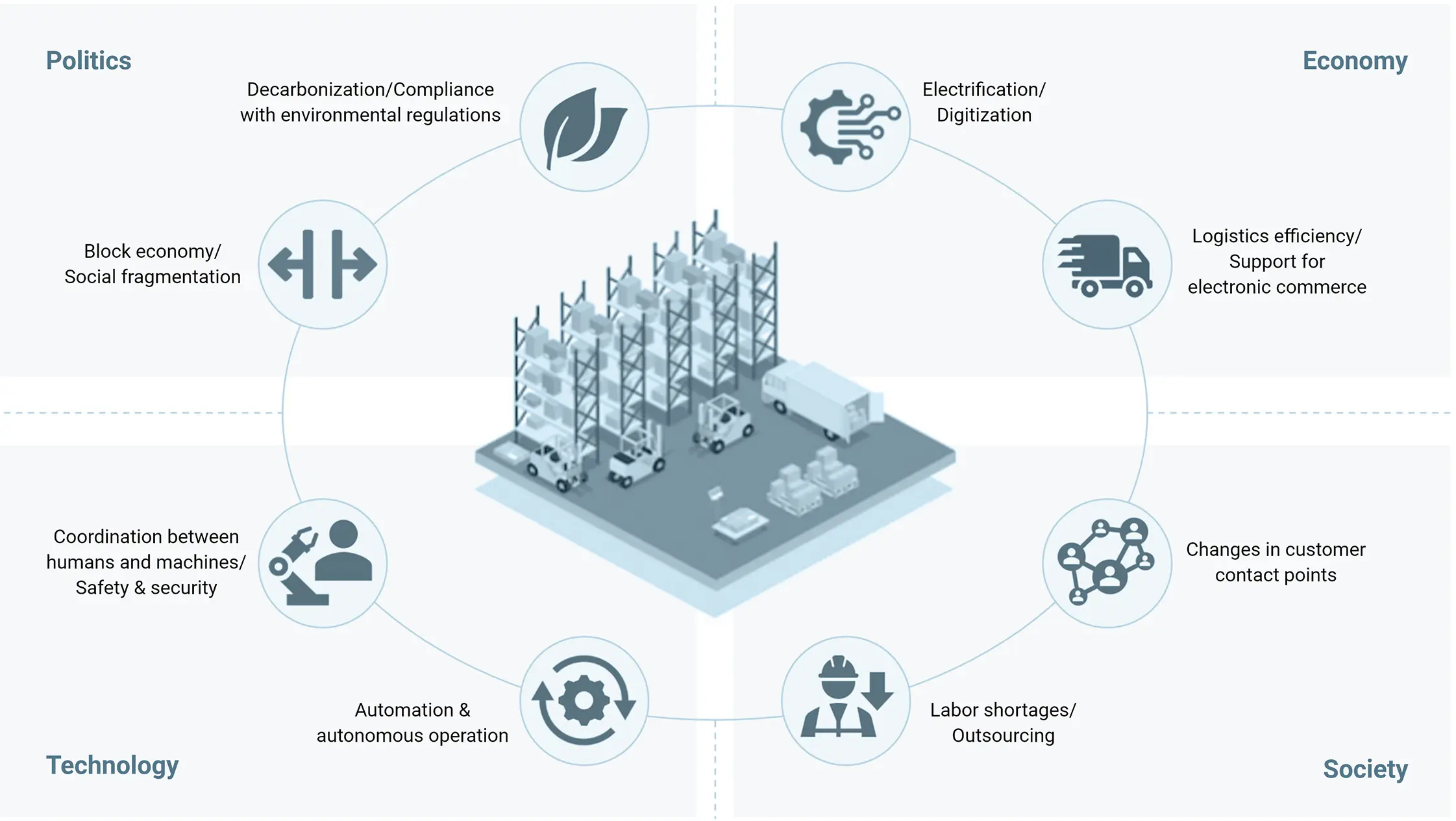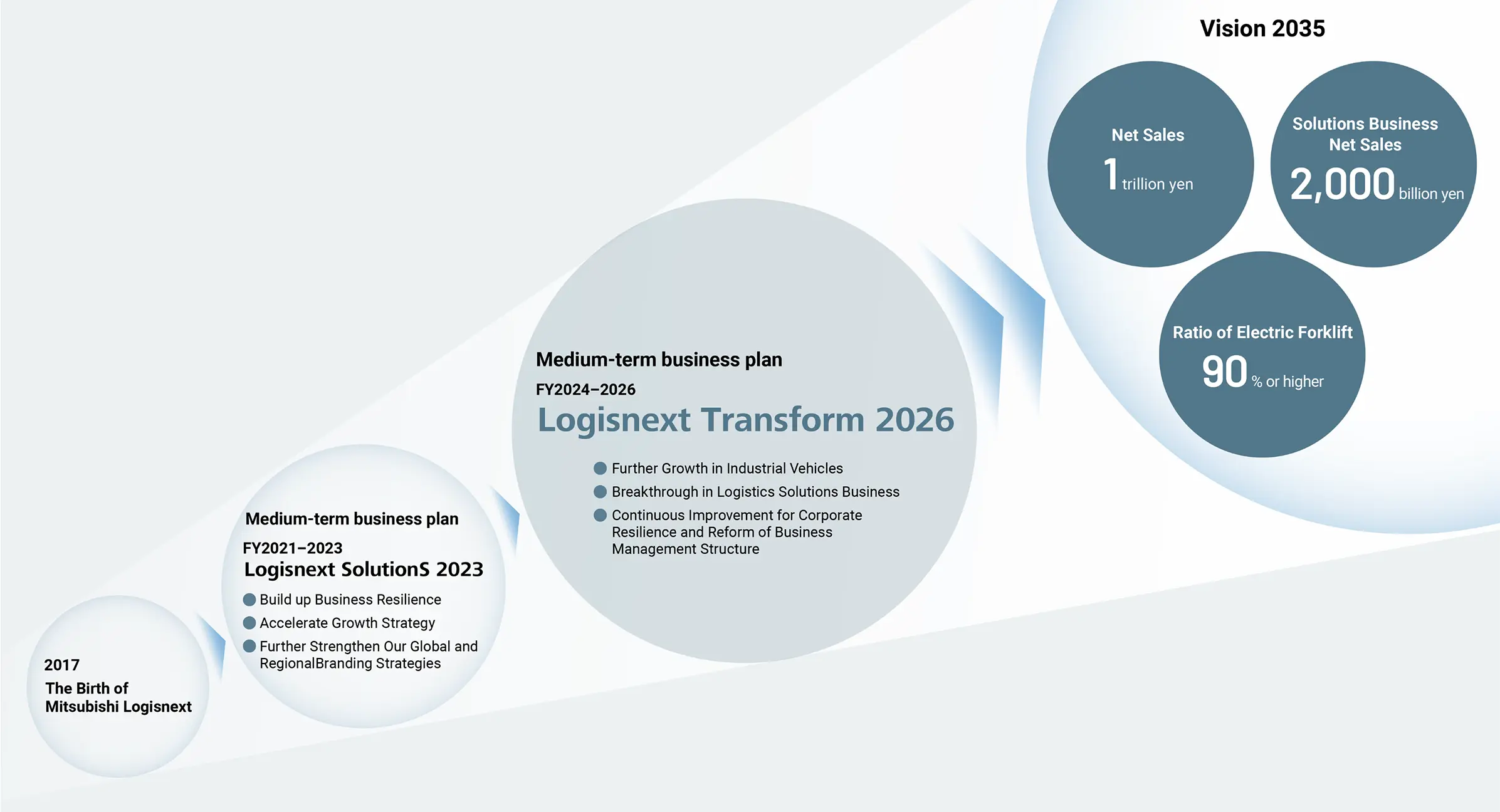Business Strategies
Since its founding in 2017, the Mitsubishi Logisnext Group has remained focused on promoting its business according to our medium-term business plan that emphasizes growth and expansion.
As we expect major changes to emerge in the environment surrounding the logistics industry, we have revealed a plan we call “Vision 2035” as a guideline for achieving this future growth in 2023.
Additionally, we have developed the medium-term business plan, Logisnext Transform 2026, using a backcast approach to achieve our objectives. This plan addresses key issues in light of the current business environment, building on the initiatives from the previous medium-term business plan.
Business Environment and Needs
In the market environment surrounding the logistics industry through 2035, with the major trend toward decarbonization, automation and autonomy will continue to progress, while manned forklift trucks will continue to play an active role in a wide range of fields as in the past.
As a result, “Connecting machines,” “Human-machine cooperation,” and “Safety and security” will become more important, and the need to connectivity will emerge more prominently.
In this environment, we will strive for further growth under the slogan “From Consolidation to Growth” toward the year 2035 in order to realize our Purpose: “We positively impact the lives of people around the world by demonstrating a pioneering spirit and using emerging technologies to deliver safe, automated and decarbonized logistics solutions”.

Achieving the Long-Term Business Vision 2035
As we expect major changes to emerge in the environment surrounding the logistics industry, we have formulated our “Long-Term Business Vision 2035” as our ideal future state. “Long-Term Business Vision 2035” outlines two growth strategies that we should focus on, and we aim to realize it through business development in line with these strategies.
Two growth strategies that we should focus on to realize
“Long-Term Business Vision 2035”
- 1. Supporting decarbonization as well as safety and security in the market for forklifts and other industrial vehicles.
- 2. Provision of automated and autonomous vehicles to fulfill the second pillar of our business, which is to meet the twin needs of “connectivity” and “automation and autonomous operation.” We will also provide solutions to link these technologies and implement them in a safe and secure manner.

FY2024–2026
Medium-term business plan

We have developed a three-year medium-term business plan for fiscal 2024 to fiscal 2026. Centered around the three key needs in logistics equipment—safety and security, automation and autonomy, and decarbonization—we aim to accelerate our transformation in the rapidly evolving business environment and take on the challenging of driving further change in the logistics industry.
Medium-term business plan key concepts
Regional Core Strategies

Americas
Specific Issues
- Accelerate shift to electric forklifts
Regional Strategies
- Release new electric forklifts and increase the production capacity of electric forklifts.
- Expand AGF/AGV sales and strengthen system engineering capabilities.
Europe
Specific Issues
- Promote advanced technologies
Regional Strategies
- Develop and release an integrated control system that supports human-machine cooperation.
- Globally deploy sales of electric forklifts and AGF models developed in Europe.
Japan
Specific Issues
- Improve profitability
Regional Strategies
- Expand service revenue by using digital tools to improve work efficiency.
- Promote automation and saving labor by offering systems that include peripheral equipment.
APAC (Asia and the Pacific) / China
Specific Issues
- Improve competitiveness and deploy in new markets
Regional Strategies
- Develop new markets by releasing cost-competitive products.
- Significantly improve the efficiency of production and sales functions.
Core Strategies
Release new products for decarbonizing society.
| Europe |
|
|---|---|
| Americas |
|
| Japan |
|
| Global |
|
Expand/Improve line of high value-added products that help ensure safety and security
- Expand/improve functionality and services for supporting customer safety and security in all sorts of logistics scenarios.
- Actively cooperate with business partners to create added value in combination with key Mitsubishi Logisnext technologies.
Accelerate deployment of business in new markets.
- Release new AGV/AGF products based on automation/autonomy.
- Develop system that supports human-machine cooperation.
- Strengthen our ability to make connections and solve problems based on maximum use of customer contacts.
Global automation market
The global automation market in 2026 is expected to almost double compared to 2020 and is projected to expand even further.
We will continue to elevate the presence of “Logisnext” in the growing automation market.

- Further improve fixed and variable cost.
- Build truly global management capabilities.
- Manage businesses with emphasis on importance of job satisfaction.
The Three Pillars of Work Satisfaction Reform
We are developing specific measures for each of the following three pillars.
*Can scroll to right
| IIncreased engagement | IIEnsuring diversity | IIICorporate Data Creating a comfortable work environment |
|---|---|---|
| Expanding human resource development programs, including encouraging employees’ self-directed skill improvement and training global talent, while fostering a corporate culture that values external learning and collaboration. | Promoting women’s participation, recruiting new graduates with a focus on women’s participation, strengthening mid-career hiring, expanding recruitment of foreign nationals, and hiring individuals with disabilities. | Introducing a flexible work system that addresses challenges such as housework, childcare, and business globalization, strengthening and promoting health management initiatives, and updating workplace equipment. |
|
|
|
Sustainable Growth for Both the Company and Our Employees
Financial targets
*Can scroll to right
| Fiscal 2026 | |
|---|---|
| Net sales | 700billion yen |
| Operating profit (before amortization of goodwill, etc.) | 56billion yen |
| Operating profit margin (before amortization of goodwill, etc.) | 8.0% |
| Capital adequacy ratio | More than30% |
| ROE | More than20% |
“Logisnext Transform 2026” plan rates: USD = 130.00 yen; EUR = 140.00 yen
Non-Financial Targets
This is the first time our company has announced non-financial quantitative targets. We have chosen indicators that are closely aligned with the execution and success of our core strategies.
*Can scroll to right
| Indicator | Fiscal 2026 | ||
|---|---|---|---|
| Decarbonization | Scope1,2 | Emission reduction rate (relative to 2017) | -33% |
| Scope 3 category 11 | Emission reduction rate (relative to 2017) | -29% | |
| Automation / Autonomy | Sales amount of the solutions business | 60billion yen | |
| Job Satisfaction | Engagement / Motivation | Job motivation Number of active workplaces | 52deviation value 32 workplaces |
| Work-style reforms | Take-up rate of paid leave | 80% | |
| Promoting the participation and advancement of female employees | Ratio of female managers | 5% | |
| Take-up rate of childcare leave for male employees | 60% | ||
| Ensuring diversity of human resources | Ratio of female hires | 30% | |
| Ratio of mid-career hires | 40% | ||
Financial Policy
We aim to generate ample free cash flow by consistently growing profits and optimizing working capital. This free cash flow will be allocated in a balanced approach toward strategic investments, strengthening our financial position, and delivering returns to shareholders.
Shareholder Returns Policy
Our fundamental policy is to provide stable and consistent dividends, unaffected by short-term fluctuations in business performance caused by sudden economic changes. We aim to maintain stable dividends with a target Dividend on Equity Ratio (DOE) of 2.0% through fiscal 2025, coinciding with the completion of goodwill amortization related to the acquisition of the former UniCarriers Corporation.

